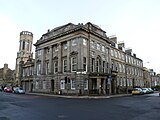Constitution Street
55°58′23″N 3°10′06″W / 55.97306°N 3.16833°W

Constitution Street is a
History
The street takes its name from Constitution Hill, which stood on the site of the current Assembly Rooms. The 1777 map of Leith calls it Constitution Road but it only goes from the eastern entrance to South Leith Churchyard to Bernard Street.[1]
The street at its current length was only completed in 1800, at that time being built as a bypass from
The bulk of the buildings lining the street remain substantially unchanged for over a century, but the previously industrial north end is now largely redeveloped as housing.
Notable events
On 9 January 1823 the last two men executed for
Appearance in films
- The Conquest of the South Pole (1989) starring Ewen Bremner and John Michie
- Trainspotting (1996) starring Ewen Bremner and Ewan McGregor
- Sunshine on Leith (2013) starring Peter Mullan
Transport
Tram

Constitution Street has tram stops at both its north and south ends. The southern end of the street is tram-only.
Foot of the Walk
| Preceding station | Edinburgh Trams | Following station | ||
|---|---|---|---|---|
| The Shore towards Newhaven |
Newhaven – Edinburgh Airport | Airport
|
The Shore
| Preceding station | Edinburgh Trams | Following station | ||
|---|---|---|---|---|
| Port of Leith towards Newhaven |
Newhaven – Edinburgh Airport | Airport
|
Notable buildings
In the clearances of the 1950s, although mainly centred on the Kirkgate to the west, Constitution Street lost some buildings of importance, notably Lord Balmerino's House dating from around 1670.[4]
East of Bernard Street, the most notable building is the classical Assembly Rooms, the former Leith Exchange building.
Leith Police Station, formerly Leith Town Hall, built in 1827 to a design by R & R Dickson.[5]
Church of St.James was designed by George Gilbert Scott, built in 1862. The stone spire was truncated in 1977.[6]
The churchyard at the south end links to South Leith Parish Church but is cared for by City of Edinburgh Council. The churchyard was only used for burial from the mid 17th century, earlier interments being inside the church, beneath the parishioners usual seating position (or threaded in the rafters if you had a balcony position). In 2009, an excavation linked to the construction of Edinburgh Trams unearthed several bodies just outside the churchyard wall.[7]
References
- ^ Plan of Leith 1777
- ^ "Execution". National Library of Scotland. Retrieved 28 January 2021.
- ^ Grant, James A. (1881–1883). Cassell's Old and New Edinburgh: Its History, its people and its places. Vol. VI. London: Cassell & Company. p. 243.
- ^ Survey of Leith by E J MacRae
- ^ Dictionary of Scottish Architects: Dickson
- ^ "St James's Episcopal Church and Hall (Former), 119, Constitution Street, Leith | Buildings at Risk Register". www.buildingsatrisk.org.uk. Retrieved 3 June 2020.
- ^ "Tram workers unearth human remains". The Scotsman.




